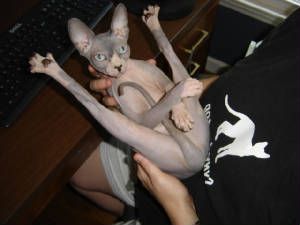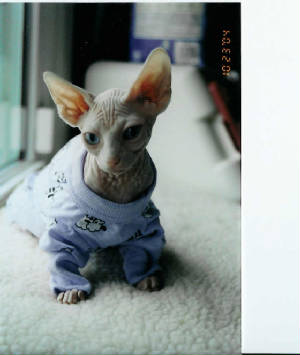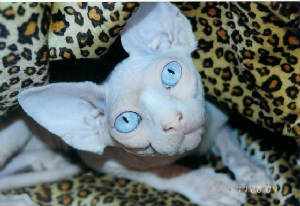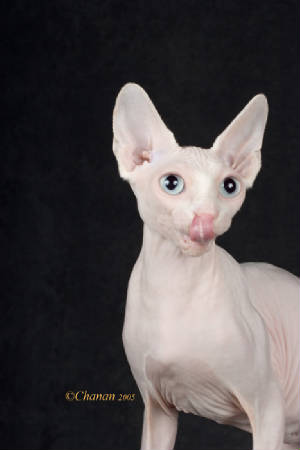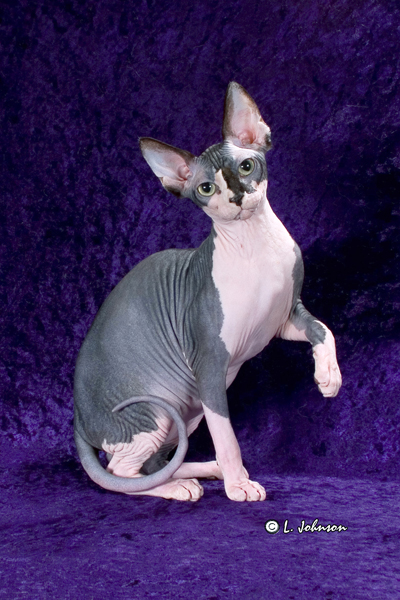In 1966 a domestic cat gave birth to a hairless kitten in Toronto, Canada. It was discovered to be a natural mutation and the Sphynx cat, as we know it today, came into existence. This cat and a few other naturally hairless cats have been found worldwide. These have magically been produced by Mother Nature and are the foundation for this unusual breed. Cat breeders in Europe and North America have bred the Sphynx to normal coated cats and then back to hairless for more than thirty years. The purpose of these selective breedings was to create a genetically sound cat with a large gene pool and hybrid vigor. This is a very robust breed with few health or genetic problems.
HEALTH:
The Sphynx is a healthy breed with no known specific health or genetic problems. Prevention is the key to perfect health. Maintaining regular vet visits and up-to-date immunizations will ward off most illnesses that would affect any cat. In general, the breed is very hardy with a normal cat’s lifespan. Neutering or spaying and providing an outlet for play, and the natural behavior of scratching (e.g. scratching post), are essential elements for maintaining a healthy long life. Sphynx cats have been know to live fifteen years or longer.
ARE SPHYNX TRULY HAIRLESS?
The Sphynx cat is not completely hairless, but has some soft fuzz on it's body, especially around the nose, feet, ear tips. But, the degree of hairlessness varies with each cat. Some can be pretty fuzzy and others as bald as a cue ball! Some people describe them as being like a warm suede hot water bottle!
ARE SPHYNX REALLY HYPOALLERGENIC?
Not necessarily. Although they are probably more tolerated than long-hair breeds, they still create dander, which is what causes allergies in the first place. Some people with allergies can get along great with Sphynx, but some people still notice problems. Needless to say, the Sphynx are not completely hypoallergenic.
BATHING:
Because Sphynx cats do not have fur to absorb the natural oils from their skin they will require periodic bathing. The build up of oils on their skin will collect dirt and dust from their surroundings, making them dirty. Depending on the amount of oils secreted from the cat, and the cleanliness of its surrounds, that will determine the frequency of bathing. Some Sphynx need to be bathed more than once a week, while others only require monthly bathing. If you keep your cat’s surroundings clean and buy dust free litter you can help reduce the frequency of bathing.
Bath time should be fun for cat and owner alike. Because bathing is a routine part of having a Sphynx, it should be introduced to kittens and made as stress free as possible. Run your bath water before bringing your Sphynx into the bathroom for a bath. Most Sphynx tolerate bathing well, but if your cat is stressed by the experience, make bath time as quick as possible and wash their face and ears after you take them out of the water.Avoid getting soap into your cat’s eyes or mouth. We use Huggies Baby Wash, Malaseb, or Equyss shampoo to bath our cats with....we love them all. We also use Johnson's Cornstarch or Gold Bond Baby Powder for powdering after bathtime, which helps to reduce oil on the skin.
CLAWS & PAWS:
Sphynx will get dirt and an oily grime on their nails and between their pads. They can be cleaned with a Huggies baby wipe or a warm wet washcloth.
The claws (front and back) will need to be clipped. In most cats you can see the vein line inside the claw and you must be very careful not to clip on or beyond it. Begin by clipping off just the tip of the claw until you are confident on how to clip. However, if you cut into the vein and cause it to bleed, dip the claw into some stypic powder to stop the bleeding.
EARS:
Sphynx’s ears are hairless and can produce a large amount of earwax, depending on the individual cat. They will need to be cleaned in conjunction with bath time or about every one to two weeks. Earwax can be easily removed with a cotton ball or Q-tip and a few drops of ear cleaner. We prefer and recomment using Zymox ear cleaner. Be very careful when cleaning their ears, and clean only as far in as you can see.
FEEDING:
You must provide your Sphynx with a constant, always accessible, supply of premium cat food and water. Here we feed a combination of kibble, raw, and canned to suite everyone. We recommend Blue Ridge Beef, Breeders Choice for feeding raw. You can find a local supplier at www.blueridgebeef.com. As for kibble, the favorite is American Journey, grain free. This can be found at www.Chewy.com. And for canned, they eat a little of everything...Ha!
CLIMATE:
Of course, the Sphynx is an indoor cat only. The general rule of thumb is...if you are comfortable, they usually are too. However, if they get a chill, they are clever enough to find a warm spot under a blanket or will curl up with another pet. Make sure you have a blankie available for them to snuggle in.
DO YOU SHIP?
We will ship, but we would much rather have the new owner(s) come to see our cattery (a.k.a. - our house) so they can see the environment in which their kitten was raised, meet the mother, and meet the other kittys in our household. (Besides, I'm a nervous mommy!) Should you need to have your kitten shipped to you, please contact me for shipping prices and to make arrangements. We only ship in good weather. And, if you reside out of state, you might consider flying in to pick up your baby. Sometimes the fares are very reasonable and that way, you wouldn't have to worry about your baby flying solo and you could meet us in person!
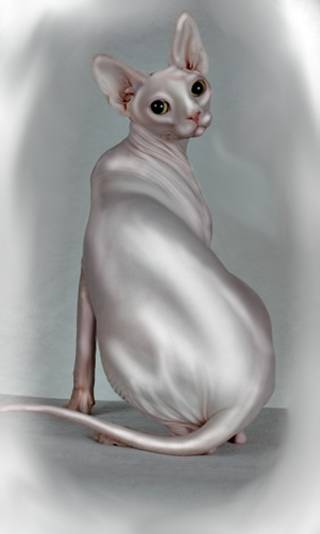
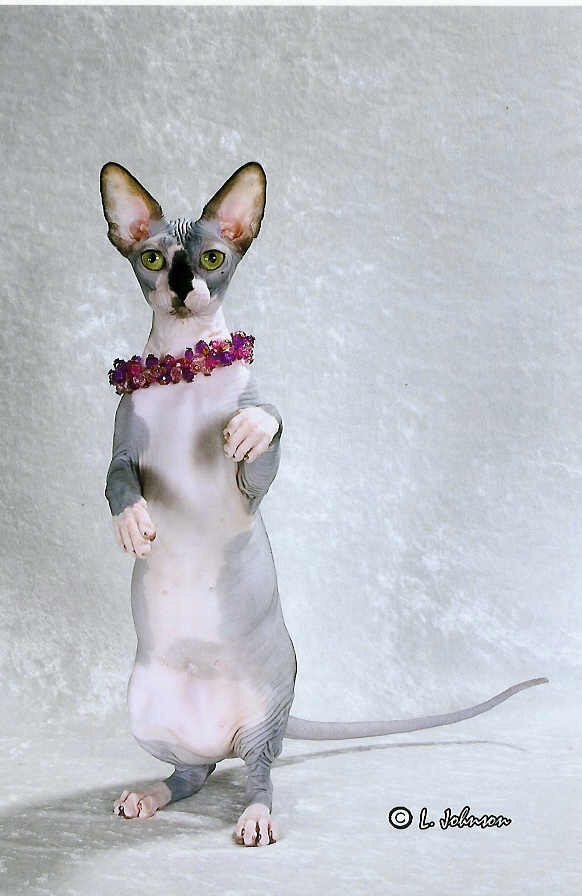 Ch. B-Bald's Crescent Moon Pie Girl
Ch. B-Bald's Crescent Moon Pie Girl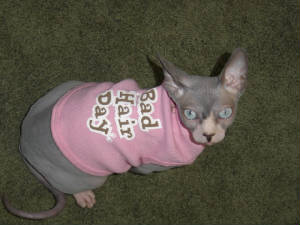 Ch. Lapecia's Nairly X-Posed of
Ch. Lapecia's Nairly X-Posed of